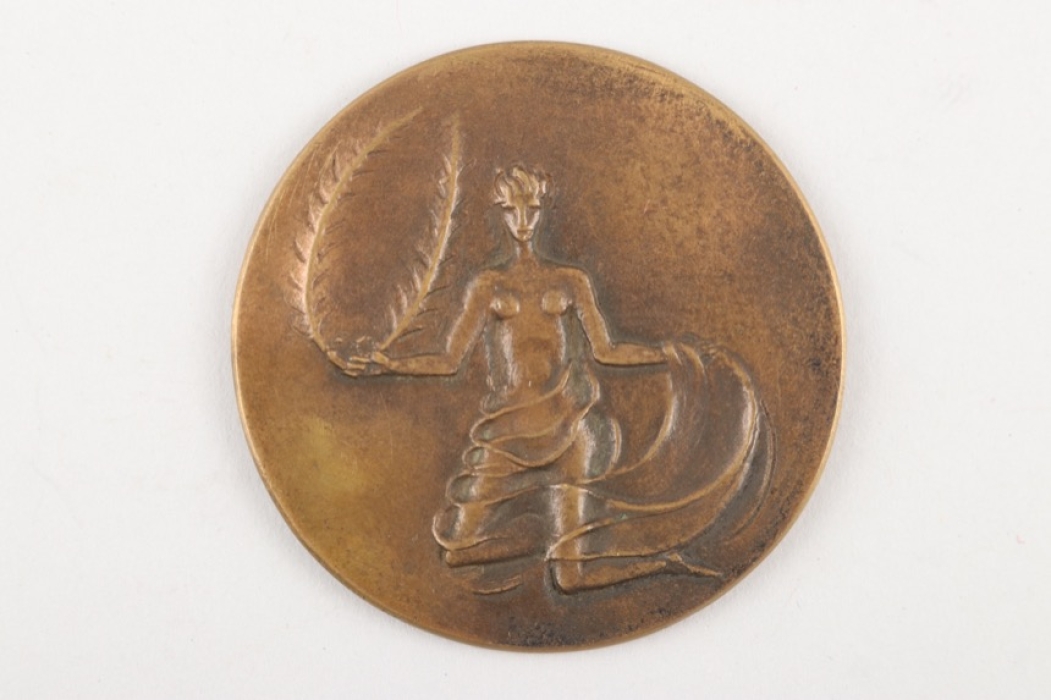Olympiade 1936 - Teilnehmerabzeichen
Jetzt Lose für verringertes Aufgeld sichern

Olympiade 1936 - Medaille Tanzwettspiele
MILITARIA PREISDATENBANK
Wie kann ich Verkaufspreise sehen?
Melden Sie sich noch heute unter www.ratisbons.com/de/militaria-preisdatenbank für unsere MILITARIA PREISDATENBANK an! Bei Abschluss eines jährlichen Abonnements für nur 75€ sparen Sie 25%.
Ihr Zugang zu allen Verkaufspreisen, Bildern und Beschreibungen wird umgehend nach Abschluss Ihres Abonnements freigeschaltet.
We are buying single items and entire collections! Call +49 8541 9053699
-
Bezahlung
-
WIE KANN ICH FÜR MEINE BESTELLUNG BEZAHLEN?
AUKTIONAlle erfolgreichen Gebote werden automatisch zu einer einzigen Bestellung zusammengefasst. Für diese können Sie uns nach Auktionsende in Ihrem persönlichen Kundenkonto Ihre bevorzugte Bezahl- und Versandart oder eine alternative Lieferadresse mitteilen.
Wenn wir diese freiwilligen Angaben nicht von Ihnen erhalten melden wir uns automatisch im Laufe des Montags nach Auktionsende mit einer Zahlungsanweisung per Email. Basierend auf Erfahrungswerten schlagen wir Ihnen die bequemste Bezahlmehtode und die günstigste Versandart vor. Sie möchten Ihre Bezahl- und Versandart ändern oder eine alternative Lieferadresse angeben? Kein Problem! Besuchen Sie Kundenkonto/BESTELLUNGEN oder kontaktieren Sie uns per Email.
BESTELLUNGEN IM ONLINESHOPWählen Sie während der Bestellung Ihre bevorzugte Bezahl- und Versandart und schicken Sie diese ab. Sie erhalten Ihre Zahlungsanweisung spätestens am darauffolgenden Tag per Email. Die Zahlungsfrist beträgt sieben Tage. Sie planen eine Bestellung per Ratenzahlung zu begleichen? Bitte sprechen Sie uns gerne vor Ihrer Bestellung darauf an.
Für mehr Informationen zu Bezahlung und Versand, besuchen Sie unsere Häufigen Fragen.
WIR AKZEPTIEREN FOLGENDE BEZAHLARTEN
-
-
Versand
-
IHRE BESTELLUNG IN DEN BESTEN HÄNDEN
VERPACKUNG & SENDUNGSVERFOLGUNGNach Zahlungseingang versenden wir Ihre Bestellung für gewöhnlich am darauffolgenden Werktag. Wir bestätigen den Eingang Ihrer Zahlung per Email und informieren Sie zur Versandvorbereitung. Nach Abholung der Sendung durch unsere Versanddienstleister teilen wir Ihnen die Sendungsnummer per Email mit. Den Status Ihrer Sendung können Sie auch jederzeit unter Kundenkonto/BESTELLUNGEN einsehen. Ihre Rechnung geht Ihnen automatisch am Tag des Versands zu.
VERSAND ZU EINER ALTERNATIVEN ADRESSEBevorzugen Sie für eine Bestellung einen Versand zu Ihrer Arbeitsstelle? Sie sind im Urlaub und wünschen den Versand zu einer Packstation oder einem Freund? Kein Problem! Diese Änderungen können Sie jederzeit unter Kundenkonto/BESTELLUNGEN vornehmen. Alternativ können Sie natürlich jederzeit auch per Email informieren.
UNSERE PARTNER FÜR DEN VERSAND
-
-
Garantie
-
 GARANTIE!
GARANTIE!Alle angebotenen Artikel werden von unseren Experten akribisch auf deren Echtheit geprüft und detailiert beschrieben. Wir bieten ausschließen zeitgenössiche Originale an. Etwa 15% aller Kundeneinlieferungen ensprechen unseren Anforderungen nicht und werden retourniert.
Gekauft wie gesehen? Nicht bei uns. Im Gegensatz zu traditionellen Auktionshäusern bieten wir volles Rückgaberecht of Originalität an. Sollten Sie mit Ihrer Bestellung nicht zufrieden sein, können Sie die Bestellung innerhalb 14 Tagen widerrufen. Bitte kontaktieren Sie uns vor dem Rückversand. Für mehr Einzelheiten besuchen Sie bitte unsere häufigen Fragen.
In eigener Sache: Bieten Sie nur auf Lose, die Sie auch erwerben möchten. Bitte vermeiden Sie Gebote nach Auktionende zu stornieren. Sollten Sie ein fehlerhaftes Gebot abgegeben haben, informieren Sie uns bitte umgehend. Wir löschen Ihre Gebote gerne bis 24 Stunden vor Ende der Auktion.
-
Land Deutsches Reich 1918 - 1945
Maße 60 mm
Gewicht 54.2 g
 US Los US1-096
US Los US1-096EAN 3000000000281
 US Los US1-096
US Los US1-096Epoche 1918 — 1945
Land Deutsches Reich 1918 - 1945
Land Deutsches Reich 1918 - 1945
 US Los US1-096
US Los US1-096Deutsches Reich 1918 - 1945
Olympiade 1936 - Teilnehmerabzeichen
Beschreibung
Price or commemorative medal for the Dance Competitions during the 1936 Olympic Games. Bronze cast in great conditions.
In 1936, dance was one art form that the Germans wanted to add to their Art Competitions during the Olympic Games, along with Gold and Silver Smithing, and Works of the Screen (sport film). Expanding the subcategories in each of the five art disciplines, which would have increased the number of medals as well as the number of potential participants, was the German goal for the Berlin Games. Approval by the International Olympic Committee, however, was required and none was forthcoming, not for the addition of Dance, nor for Gold and Silver Smithing or Works of the Screen. Dance, however, played a significant part both before, and during, the 1936 Olympic Games in Berlin, Germany. Nazi organizers sought to draw international attention to the achievements of their leader, Adolf Hitler, and one way to succeed was through the popular medium of dance. Noted German choreographers and dancers of the day were enlisted to play a part in the Olympic program: Rudolf von Laban, Mary Wigman, and Harald Kreutzberg. In her book, Modern Dance in Germany and the United States: Crosscurrents and Influences, Isa Partsch-Bergsohn details Laban's extensive involvement with Olympic preparations as follows: "Laban, a master at arranging mass scenes in choral dancing, was commissioned to direct the triumphal celebration of German Dance at the Dietrich Eckart Freilichtbühne (Outdoor Theater) and to organize a Great International Dance Competition in July 1936." The dance celebration to inaugurate the Dietrich Eckart stage at the Olympic grounds took place on the opening night of the Games.
From: “The Role of Dance in the 1936 Berlin Olympic Games” out of “SEVENTH INTERNATIONAL SYMPOSIUM FOR OLYMPIC RESEARCH” by ELIZABETH A. HANLEY, Pages 133 ff.
Zustand
1-
Verkäufer
History Trader Inc., 521 Thorn Street #165, Sewickly, PA 15143-0165, USA


